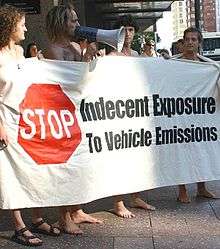Indecent exposure

Indecent exposure is the deliberate exposure in public or in view of the general public by a person of a portion or portions of their body, in circumstances where the exposure is contrary to local moral or other standards of appropriate behavior. The term indecent exposure is a legal expression. Social and community attitudes to the exposing of various body parts and laws covering what is referred to as indecent exposure vary significantly in different countries. It ranges from outright prohibition to prohibition of exposure of certain body parts, such as the genital area, buttocks or breasts.
Decency is generally judged by the standards of the local community, which are seldom codified in specifics in law. Such standards may be based on religion, morality or tradition, or justified on the basis of "necessary to public order".[1] Non-sexual exhibitionism or public nudity is sometimes considered indecent exposure. If sexual acts are performed, with or without an element of nudity, this can be considered gross indecency, which is usually a more serious criminal offence. In some countries, exposure of the body in breach of community standards of modesty is also considered to be public indecency.
The legal and community standards of what states of undress constitute indecent exposure vary considerably and depend on the context in which the exposure takes place. These standards have also varied over time, making the definition of indecent exposure itself a complex topic.
Overview
It is generally accepted, at least in western countries, that a naked human body is not in itself indecent. That principle is reflected, for example, in depiction of the human form in art of various forms. Nevertheless, as a general rule, it is also commonly expected that people when they appear in a public place will be appropriately attired. Inappropriateness is viewed in context, so that, for example, what may be appropriate on a beach may be inappropriate in a street, school or workplace. Depending on the context, some degree of inappropriateness may be tolerated, and perhaps described as eccentric, but in extreme cases of inappropriateness it may be regarded as "crossing the line". Besides the social disapproval of such a state of dress, most jurisdictions have laws to "maintain social order", variously described as public nudity, indecent exposure, as an affront to public morality, public nuisance, besides others. What is an inappropriate state of dress in a particular context depends on the standards of decency of the community where an exposure takes place. These standards vary from time to time and can vary from the very strict standards of modesty in places such as Afghanistan and Saudi Arabia, which require most of the body to be covered, to tribal societies such as the Pirahã or Mursi where full nakedness is the norm.[2] There is generally no implication that the state of dress objected to is of a sexual nature; and if such an allegation were to be made, the act would generally be described as "gross indecency".
The standards of decency have varied over time. During the Victorian era, for example, exposure of a woman's legs and some extent the arms, was considered indecent in much of the Western world. Hair was sometimes required to be covered in formal occasions as in a form a hat or bonnet. As late as the 1930s and to some extent, the 1950s, both women and men were expected to bathe or swim in public places wearing bathing suits that covered above the waist. An adult woman exposing her navel was also considered indecent in the West into the 1960s and 1970s, and even as late as the 1980s. Moral values changed drastically during the 1990s and 2000s, which in turn changed the criteria for indecent exposure. Public exposure of the navel has been accepted during the 1990s, such as in beaches, while in the 2000s, the buttocks can be exposed while wearing a thong. Today, however, it is quite common for women to go topless at public beaches throughout Europe and South America and even some parts of the United States.[3]
Although the phenomenon widely known as flashing, involving a woman exposing bare nipples by suddenly pulling up her shirt and bra, may be free from sexual motive or intent, it nonetheless is public exposure and is therefore defined by statute in many states of the United States as prohibited criminal behavior.[4]
The motivation of the exposure is sometimes based on it being unusual, attention-getting, sexually arousing, or separately, as in a public policy protest, inappropriate and to show disrespect to the enemy side. The effects (including negative consequences) may be enhanced by intended or unintended publication of a photograph or film of the act, which would also include mooning.
Breastfeeding in public does not constitute indecent exposure under the laws of the United States, Canada, Australia, or Scotland.[5] In the United States, the federal government and all 50 states[6] have enacted laws specifically protecting nursing mothers from harassment by others. Legislation ranges from simply exempting breastfeeding from laws regarding indecent exposure, to outright full protection of the right to nurse.[7]
Public clothing
Public clothing varies by country and may be regulated by law. What parts of the body must be covered varies by region. Although genitals are usually expected to be covered in public in almost all societies, when it comes to other parts of the body such as female breasts, midriff, legs or shoulders, norms vary. For example, in some African cultures, it is the thighs, not the breasts, which must be covered.[8] In some societies, the head hair, especially female, must be covered, usually with a scarf. The vast majority of cultures accept that the face can and must be seen, but some cultures (especially in the Middle East), require that it be covered under a burqa. In conservative societies, appearing in a public place in clothing that is deemed 'indecent' is illegal.[9][10][11] In many countries there are exceptions to the general rules (social or legal) regarding clothing. For instance, a country which generally prohibits full nudity may allow it in designated places, such as nude beaches, or during various social events such as festivals or nude protests.
Europe
Attitudes towards nudity vary by country and are generally most relaxed in Scandinavia, where genitals and breasts are not normally considered indecent or obscene. Hence, laws and societal views on public nudity are generally relaxed.[12] In Finland, it is very typical for patrons to bathe nude in the intense heat of saunas.
In the Netherlands, public nudity is allowed at sites that have been assigned by the local authorities and "other suitable places."[13] On nudist beaches, in unisex saunas and in swimming pool changing rooms, remaining partially clothed is frowned upon and the social norm is to undress.
In Barcelona, public nudity was a recognised right. However, on 30 April 2011, the Barcelona City Council voted a by-law forbidding walking "naked or nearly naked in public spaces" and limiting the wearing of bathing costumes to pools, beaches, adjacent streets and sea-side walks.[14]
Other countries, such as the UK, Ireland or Poland[15] are more conservative.
United Kingdom
In the United Kingdom during the 19th and 20th centuries, indecent exposure was prosecuted under either section 28 of the Town Police Clauses Act 1847[16] or section 4 of the Vagrancy Act 1824. The latter was a piece of legislation that made it an offence to sleep rough or beg and contained a provision for the prosecution of:
- every person wilfully openly, lewdly, and obscenely exposing his person in any street, road, or public highway, or in the view thereof, or in any place of public resort, with intent to insult any female...
This provision was repealed by section 66 of the Sexual Offences Act 2003 which replaced the offence of "indecent exposure" and other sexual offences with legislation that is more specific and explicit.[17] Current laws apply only to genital exposure with intent to shock those who do not want to see them. The maximum penalty is two years' imprisonment, but this is extremely rare as most cases are dealt with by a fine or through community service.[18][19] People convicted of exposure contrary to section 66 of the Sexual Offences Act 2003 must sign the Violent and Sex Offender Register if they are sentenced to a term of imprisonment or a community order in excess of 12 months, or if the person they exposed themselves to was aged under 18.[20]
Public nudity in England and Wales can also be punished as "disorderly behaviour" under the Public Order Act 1986, sections 4A and 5.[21]
In Scotland and Northern Ireland the situation is more complex, as some sections of the Sexual Offences Act 2003 extend to these places and some do not. Under Scots law, indecent exposure is considered to be a form of public indecency and is regarded as a crime of indecency. Scots law has been known to respond differently from English and Welsh law in cases of indecent exposure. Stephen Gough, a man known as the "Naked Rambler" who hikes across Britain wearing only shoes, has been arrested in both jurisdictions with different consequences in each. The Northern Ireland Assembly has considered the introduction of new legislation.
United States
The laws governing indecent exposure in the United States vary according to location. In most states public nudity is illegal. However, in some states it is only illegal if it is accompanied by an intent to shock, arouse or offend other persons. Some states permit local governments to set local standards. Most states exempt breastfeeding mothers from prosecution.
Canada
In Canada, s.173 of the Criminal Code[24] prohibits "indecent acts".[25] There is no statutory definition in the Code of what constitutes an indecent act, other than the exposure of the genitals and/or female nipples for a sexual purpose to anyone under 16 years of age. Thus, the decision of what states of undress are "indecent", and thereby unlawful, is left to judges. Judges have held, for example, that nude sunbathing is not indecent.[26] Also, streaking is similarly not regarded as indecent.[27][28] Section 174 prohibits nudity if it offends "against public decency or order" and in view of the public. The courts have found that nude swimming is not offensive under this definition.[29]
Toplessness is also not an indecent act under s.173. In 1991, Gwen Jacob was arrested for walking in a street in Guelph, Ontario while topless. She was acquitted in 1996 by the Ontario Court of Appeal on the basis that the act of being topless is not in itself a sexual act or indecent.[30] The case has been referred to in subsequent cases for the proposition that the mere act of public nudity is not sexual or indecent or an offense.[31] Since then it is legal for a female to walk topless in public anywhere in Ontario, Canada.[32]
Australia

In Australia, it is a summary or criminal offence in some States and Territories to expose one's genitals (also referred to as - 'his or her person')[33] in a public place or in view of a public place. In some jurisdictions exposure of the genitals alone does not constitute an offence unless accompanied by an indecent act, indecent behaviour, grossly indecent behaviour, obscenity, intention to cause offence or deliberate intention. The applicable law is different in each jurisdiction and in several jurisdictions the offence of indecent exposure does not apply.
Penalties vary between jurisdictions and are summarised below. Specific state Acts, are as follows:
- Australian Capital Territory – Crimes Act 1900, section 393 – 'indecent exposure' – penalty 12 months. Under the Nudity Act 1976, the responsible minister may declare a public area where public nudity is permitted.[34][35]
- New South Wales – Summary Offences Act 1988, section 5 – 'wilful and obscene exposure' – penalty six months.[36]
- Northern Territory – Summary Offences Act, section 50 – 'indecent exposure' – penalty 6 months.[37]
- South Australia – Summary Offences Act 1953, section 23 – 'Indecent behaviour and gross indecency' – penalty three months and six months respectively.[38]
- Queensland – Summary Offences Act 2005 No. 4, section 9 – 'wilful exposure' – penalty 12 months.[39]
- Tasmania – Police Offences Act 1935, section 21 – 'Prohibited behaviour' – penalty 12 months.[40] Police Offences Act 1935, section 14 – 'Public decency' – one penalty unit.[41]
- Victoria – Summary Offences Act 1966, section 19 – 'wilful and obscene exposure' – penalty two years.[42] Under the Nudity (Prescribed Areas) Act 1983<refNudity (Prescribed Areas) Act 1983 (Vic)</ref> the responsible minister may declare a public area where public nudity is permitted.
- Western Australia – Criminal Code, section 203 – 'Indecent acts in public' – criminal penalty two years. Summary conviction penalty: 9 months and fine of $9,000.[43]
Definition of person
The laws of New South Wales, the Australian Capital Territory and the Northern Territory use the term "person", while in the other States the exposure refers to the genital area. It has been noted that a term such as "exposing one's person" relates back to the United Kingdom Vagrancy Act 1824 and Evans v Ewels (1972)[44] where it was said that the word "person" was a genteel synonym for "penis" or "vulva". However, it has been held that the word "person" in s5 of the (NSW) Summary Offences Act is not limited to "penis" or "vulva". For example, in R v Eyles (1997) the offender was seen masturbating in his front garden and charged with obscene exposure under the NSW Act.[33][36]
- In the case of both males and females, the parts of the body which are capable of being employed for the purpose of obscene exposure are limited. The concepts of obscenity and exposure in a practical sense restrict the potential operation of the provision. There is a question as to whether there is any further restriction to be found in the word "person". The Crown Advocate has submitted that there may be circumstances in which the exposure of the breasts of a woman is capable of being regarded as obscene, and that it is not difficult to imagine circumstances in which the exposure of a person's buttocks could be obscene.[33]
However –
- It is unnecessary and inappropriate to decide in the present case whether her submissions in that regard are correct. The jurisdiction which this Court is exercising is a jurisdiction confined to determining questions of law which arise in the case before the District Court. No question arises in the present case as to whether there are any circumstances in which the exposure by a female of breasts, or by a female or male of buttocks, could involve a contravention of s5. The prosecution case against the appellant was that he obscenely exposed his penis and other genitals. It is sufficient for resolution of the present case to say that this was capable of constituting exposure of "his person" for the purposes of the proceedings against him.[33]
India and Middle East
The Indian Penal Code (IPC) is often used to charge sex workers with vague crimes such as "public indecency" or being a "public nuisance" without explicitly defining what these consist of.
Saudi Arabia arrests people who are non indecent. Women without headscarves are considered indecent for some reason. [45]
See also
- Anasyrma
- Clothing laws by country
- Exhibitionism
- Intimate parts in Islam
- Islam and clothing
- Modesty
- Mooning
- Nudity and children
- Obscenity
- Public display of affection
- Public sex
- Public urination and Open defecation
- Sex crime
- Social nudity
- Streaking
- Toplessness
- Underwear as outerwear
- Vulgarity
- Wardrobe malfunction
References
- ↑ "Indecent exposure". Merriam-Webster's Collegiate Dictionary (Tenth ed.). Merriam-Webster. 2001. p. 589. ISBN 0-87779-713-7.
- ↑ "Legality of Nudism in Public Places?". politics.stackexchange.com. Retrieved 2018-03-02.
- ↑ "Here's Where It's Legal for Women to Go Topless in the U.S." Time. Retrieved 2018-03-02.
- ↑ "Criminal Code". Topical Index: State Statutes 2. Cornell University Law School. Retrieved 2010-09-14.
- ↑ "Breastfeeding etc. (Scotland) Act 2005". Retrieved 2007-05-22.
- ↑ Sonja Haller (25 July 2018). "Finally! In 2018 it's legal to breastfeed in public in all 50 states". USA Today.
- ↑ Samakow, Jessica (2014-08-01). "These Are All The States Where It's Legal To Breastfeed In Public". Huffington Post. Retrieved 2018-03-02.
- ↑ Tom Holloway (15 May 2003). "MPs defend Swazi bare breasts". BBC News.
- ↑ "Nigerian skimpy dressers arrested". BBC News. 27 July 2007.
- ↑ "Inquiry into Saudi TV presenter's clothing". BBC News. 27 June 2018.
- ↑ Frances Harrison (27 April 2007). "Crackdown in Iran over dress codes". BBC News.
- ↑ Einhorn, Eric S.; Logue, John (2003). Modern Welfare States: Scandinavian Politics and Policy in the Global Age. Oxford: Harcourt. p. 309. ISBN 0-275-95044-1.
- ↑ Nudity and the law Archived 12 October 2007 at the Wayback Machine.
- ↑ APNEL
- ↑ "Model fined for sunbathing topless; Ombudsman appeal mulled". ABS-CBN News. AFP. 8 November 2008.
- ↑ "Town Police Clauses Act 1847 (as enacted)" (PDF). Legislation.Gov.Uk. Retrieved 19 May 2018.
- ↑ Cox, David J.; Stevenson, Kim; Harris, Candida; Rowbotham, Judith (2015). Public Indecency in England 1857-1960: 'A Serious and Growing Evil’. SOLON Explorations in Crime and Criminal Justice Histories. Volume 6. Routledge. p. 144. ISBN 9781317573838.
- ↑ Legislation.gov.uk. "Sexual Offences Act 2003". Retrieved 2010-09-14.
- ↑ "Equality Act 2010". legislation.gov.uk. The National Archives. Retrieved 9 February 2017.
- ↑ Dan Bunting (7 April 2015). "Sex Offenders Register". UK Criminal Law Blog.
- ↑ "Freedom of expression – nakedness in a public place - UK Human Rights Blog". UK Human Rights Blog.
- ↑ Goodman, J. David (May 15, 2013). "See Topless Woman? Just Move On, Police Are Told". Retrieved 25 August 2013.
- ↑ Bonaguro, Alison (10 July 2015). "Why Are Women's Nipples Banned in Public and on Instagram, but Men's Nipples Aren't?". Men's Health. Retrieved 25 September 2017.
- ↑ "Criminal Code of Canada, 1985, Part V, Sexual Offences". Efc.ca. Retrieved 2013-03-14.
- ↑ Part 173(1)(a) of the Criminal Code provides, in part - Indecent acts - 173. (1) Every one who wilfully does an indecent act (a) in a public place in the presence of one or more persons...is guilty of an offence punishable on summary conviction.
- ↑ R. v. Beaupré, 1971, British Columbia Supreme Court. Held: "the phrase 'indecent act' connotes something more active, with greater moral turpitude than the mere state of being nude in a public place."
- ↑ R v Springer, 1975, Saskatchewan District Court
- ↑ R v Niman, 1974, Ontario Provincial Court
- ↑ R. v. Benolkin, 1977, Saskatchewan Court of the Queen's Bench. It was found that "It cannot be an offence to swim in the nude at a lonely place in Canada in summer. That is part of the pleasure of summer in Canada, particularly to young males. If somebody comes along unexpectedly or if the swimmer misjudged the loneliness of the place the act cannot suddenly become criminal.".
- ↑ "Judgment C12668, R. vs. Jacob". Province of Ontario Court of Appeal. 1996-12-09. Retrieved 2009-02-16.
- ↑ District of Maple Ridge v. Meyer, 2000 BCSC 902 (CanLII). See esp. para [49] and [55].
- ↑ Amy Dempsey (28 August 2010). "Topless in Guelph: It started out as a shy event". Toronto Star.
It’s been nearly 20 years since Gwen Jacob took a history-making topless jaunt through downtown Guelph. It’s been 15 years since charges against her were overturned in a case that gave Ontarian woman the legal right to be topless in public — a right previously exclusive to men.
- 1 2 3 4 R v Eyles [1997] NSWSC 452 (1 October 1997), Court of Criminal Appeal (NSW, Australia).
- ↑ Crimes Act 1900 (ACT) s 393 Indecent exposure.
- ↑ Nudity Act 1976 (ACT).
- 1 2 Summary Offences Act 1988 (NSW) s 5 Obscene exposure.
- ↑ Summary Offences Act (NT) s 50 Penalty for indecent exposure of the person.
- ↑ Summary Offences Act 1953 (SA) s 23 Indecent behaviour and gross indecency .
- ↑ Summary Offences Act 2005 (Qld) s 9 Wilful exposure.
- ↑ Police Offences Act 1935 (Tas) s 21 Prohibited behaviour.
- ↑ Police Offences Act 1935 (Tas) s 14 Public decency.
- ↑ Summary Offences Act 1966 (Vic) s 19 Wilful and obscene exposure.
- ↑ Criminal Code (WA) section 203.
- ↑ Evans v Ewels [1972] 1 WLR 671.
- ↑ https://www.theguardian.com/world/2017/jul/20/saudi-woman-arrested-for-wearing-a-skirt-is-released-without-charge
<?

